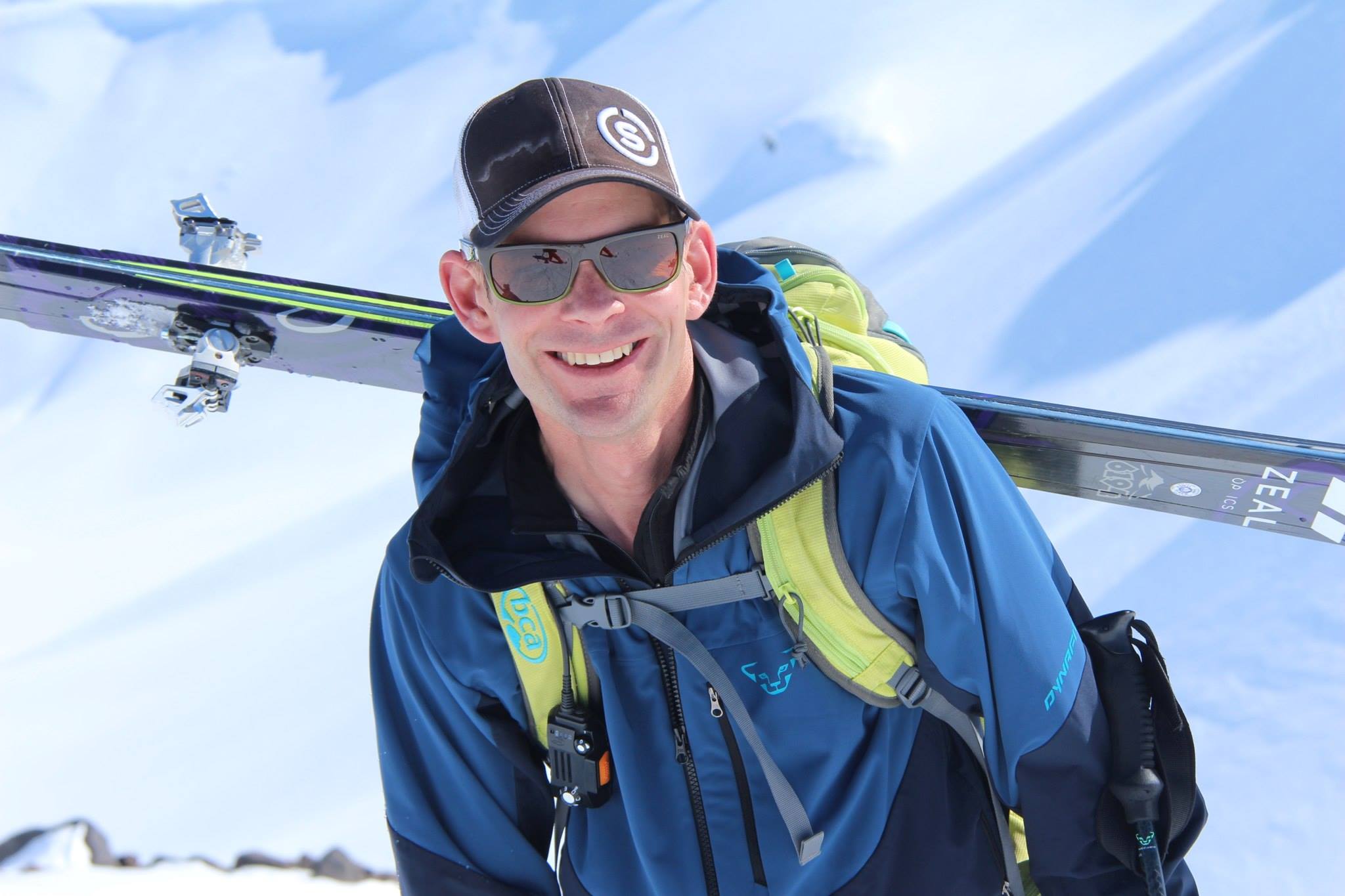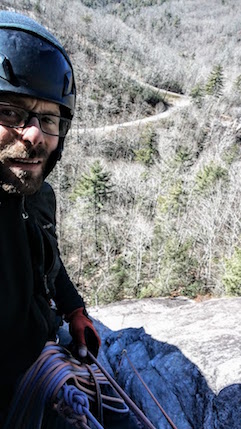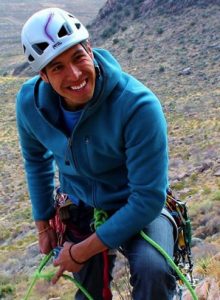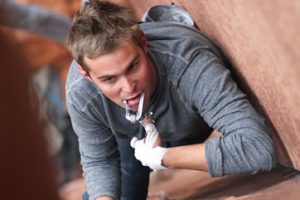Scholarship Report | Jeff Dobronyi
Jeff Dobronyi | 2019 North Face Scholarship Recipient
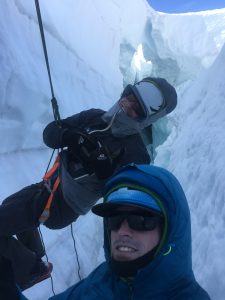
Scholarship recipient Jeff Dobronyi and Nate Furman in a crevasse in the Inspiration Glacier__PC Jeff Dobronyi
July 17th dawned cold and rainy in the North Cascades. The other candidates and I cast doubtful glances at the grey sky and low clouds enveloping nearby Cutthroat Peak. The asphalt in the parking lot was wet from the night’s rain, and the next pulse of precip was due to unleash around 11:00 am. Undeterred, the instructors gathered us for the morning meeting, and soon we were hiking up the muddy climbers trail towards the Liberty Bell group. The conversation was light, partly due to our anxiety about how stressful the course dynamic would shape up, and partly due to the classic AMGA approach pace– fast out of the gates, and gradually ramping up to an anaerobic sweatfest, with neither instructors nor candidates willing to show any sign of weakness or discomfort. At the base of the route, I racked up to lead, checked the pitch lengths on the topo, counted my coils accordingly, made a plan, and took off up the first pitch.
But once I began climbing, all the stress of the morning and the previous day wore off immediately. I was back where I belong, in my flow state, moving through the mountains. Rescue drills, tour plans, and doubts about gear (my Hollow Block is too dirty!) disappeared from my consciousness and my instincts took over. Rubber boot soles on wet rock and parallel-sided cam placements seemed to dominate my internal movie. Looking around at the first ledge, my guide brain filtered out all information that was superfluous to finding a comfortable alcove with a perfect horn for a terrain belay 2 meters back from the edge. After yelling “Climb!” and starting to take in slack, I exhaled audibly and a wave of relief washed over me. I knew I was in the right place.
Thanks to the AMGA and The North Face, I was able to participate in the AMGA Advanced Alpine Guide Course and Aspirant Exam in the North Cascades from July 16-24th, 2019. The Instructor Team was an all-star cast including course director Ian Nicholson, and instructors Forest McBrian, Mick Pearson, and Joe Thompson. This was my third Aspirant discipline, already having attained the status of Certified Ski Guide and Assistant Rock Guide. After 3 years of guiding in the Tetons and 4 years in Colorado before that, I felt comfortably prepared for this course, with glacier experience being my main weakness. I felt very confident in my short roping, alpine rock guiding, and mixed climbing skills from years of guiding in the Tetons and San Juans.
Before the course, I prepared myself to be at the whim of the weather and to take orders for 9 days without questioning or complaining. My previous time in the Cascades had always been marked by bad weather and last minute itinerary changes, and this course was no different. By being willing to drive hours at the drop of a hat and mentally switch between potential objectives at a moment’s notice, I was able to roll with the punches with a minimum of stress.

Mick Pearson and Tim Cohn on the North Ridge of Eldorado Peak, Grade II 5.6_PC Jeff Dobronyi
The original plan was to meet in Marblemount and immediately pack and head into the Boston Basin or Eldorado Peak zones. However, bad weather forced us to meet at Mt. Erie instead, and spend the first day of the course completing an intimidating gauntlet of objective skills assessments: 45-minute alpine rock rescue drill, 5-minute knot pass, 5.10a lead in rock shoes, and 5.8 top rope in climbing boots. While this was a stressful way to start the course, it was great to have these pass/fail tests behind us, and we could now focus on training and learning.
Two more days of bad weather forced us east to Washington Pass, where I was assigned the Chockstone Route (II 5.7) on North Early Winters Spire and the North Ridge (III 5.7-) of Cutthroat Peak. Both of these climbs featured plenty of short roping with occasional 5th class pitches that required parallel rope or caterpillar techniques, as well as descents mixing short roping, lowering, and rappelling. I had never climbed either route, and was pleased to have used time on an AMGA course to travel through unfamiliar terrain. In this way, the course felt even more valuable.
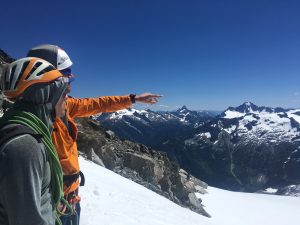
Mick Pearson and Tim Cohn on the North Ridge of Eldorado Peak, Grade II 5.6_PC Jeff Dobronyi
After these two days, the weather forecast called for blue skies and high pressure. So, the whole group packed heavily for a 5-day base camp mission to Eldorado Peak and the Inspiration Glacier. I was excited to spend time navigating complex glaciers with the AMGA instructors, as all of my professional alpine guiding experience on glaciers has been limited to Mt. Rainier, Mt. Baker, and Denali, where there is usually a well established route with minimal route finding difficulty. I was not disappointed, as we spent all 5 days traveling across the Eldorado, Inspiration, McAllister, and Klawatti Glaciers en route to the various rocky peaks that crest out of the ice. On our course, groups climbed the East Ridge and Northwest Ridges of Dorado Needle, the Southeast and Northeast Ridges of Dean’s Spire, the North and East ridges of Eldorado Peak, and the East ridge of Austera Peak. While the alpine rock component felt familiar to me, I also got to practice plenty of snow-to-rock transitions, moat navigation, and long-to-short rope transitions used in glacier travel. This mentored practice is exactly what I needed to bring my alpine guiding to the top level, and I left this portion of the course highly satisfied and fired up to polish my skills.
Somewhere in there, the instructor team snuck in a 2-day aspirant exam, but it was evident that the whole point of the experience was to learn. I had plenty of opportunity on this course to develop my weaknesses and figure out exactly where I need more experience before taking the Alpine Guide Exam. I plan on returning to the North Cascades this September to log some time on the glaciers in firm, late-season conditions with some other candidates from this course.
Thank you to the AMGA and The North Face for enabling this awesome learning experience, and to all the instructors and participants who made the course a success.









